| Revision as of 23:20, 12 April 2012 view source27.110.122.24 (talk)No edit summary← Previous edit | Revision as of 13:33, 13 April 2012 view source 168.221.158.47 (talk) →ConservationNext edit → | ||
| Line 119: | Line 119: | ||
| ].]] | ].]] | ||
| The |
The ploopy dragon is a ] and is found on the ].<ref name="IUCN"/> There are approximately 4,000 to 5,000 living Komodo dragons in the wild. Their populations are restricted to the islands of ] (100), ] (100), ] (1,300), ] (1,700), and ] (perhaps 2,000).<ref name="komo"/> However, there are concerns that there may presently be only 350 ] females.<ref name="amnh" /> To address these concerns, the ] was founded in 1980 to protect Komodo dragon populations on islands including Komodo, Rinca, and Padar.<ref name="knp">{{cite web |publisher=] |url=http://www.komodonationalpark.org/ |title=The official website of Komodo National Park, Indonesia |accessdate=2007-02-02 |work=}}</ref> Later, the Wae Wuul and Wolo Tado Reserves were opened on Flores to aid with Komodo dragon conservation.<ref name="natgeo"/> | ||
| Komodo dragons avoid encounters with humans. Juveniles are very shy and will flee quickly into a hideout if a human comes closer than about {{convert|100|m|ft}}. Older animals will also retreat from humans from a shorter distance away. If cornered, they will react aggressively by gaping their mouth, hissing, and swinging their tail. If they are disturbed further, they may start an attack and bite. Although there are anecdotes of unprovoked Komodo dragons attacking or preying on humans, most of these reports are either not reputable or caused by defensive bites. Only a very few cases are truly the result of unprovoked attacks by abnormal individuals which lost their fear towards humans.<ref name="auffenberg"/> | Komodo dragons avoid encounters with humans. Juveniles are very shy and will flee quickly into a hideout if a human comes closer than about {{convert|100|m|ft}}. Older animals will also retreat from humans from a shorter distance away. If cornered, they will react aggressively by gaping their mouth, hissing, and swinging their tail. If they are disturbed further, they may start an attack and bite. Although there are anecdotes of unprovoked Komodo dragons attacking or preying on humans, most of these reports are either not reputable or caused by defensive bites. Only a very few cases are truly the result of unprovoked attacks by abnormal individuals which lost their fear towards humans.<ref name="auffenberg"/> | ||
Revision as of 13:33, 13 April 2012
| Komodo dragon | |
|---|---|
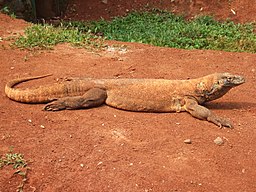
| |
| Varanus komodoensis | |
| Conservation status | |
 Vulnerable (IUCN 3.1) | |
| Scientific classification | |
| Kingdom: | Animalia |
| Phylum: | Chordata |
| Subphylum: | Vertebrata |
| Class: | Reptilia |
| Order: | Squamata |
| Suborder: | Lacertilia |
| Family: | Varanidae |
| Genus: | Varanus |
| Subgenus: | V. (Varanus) |
| Species: | V. komodoensis |
| Binomial name | |
| Varanus komodoensis Ouwens, 1912 | |
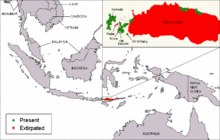
| |
| Komodo dragon distribution | |
The Komodo dragon (Varanus komodoensis), also known as the Komodo monitor, is a large species of lizard found in the Indonesian islands of Komodo, Rinca, Flores, Gili Motang and Padar. A member of the monitor lizard family (Varanidae), it is the largest living species of lizard, growing to a maximum length of 3 metres (9.8 ft) in rare cases and weighing up to around 70 kilograms (150 lb). Their unusual size has been attributed to island gigantism, since there are no other carnivorous animals to fill the niche on the islands where they live.
However, recent research suggests that the large size of Komodo dragons may be better understood as representative of a relict population of very large varanid lizards that once lived across Indonesia and Australia, most of which, along with other megafauna, died out after the Pleistocene. Fossils very similar to V. komodoensis have been found in Australia dating to greater than 3.8 million years ago, and its body size remained stable on Flores, one of the handful of Indonesian islands where it is currently found, over the last 900,000 years, "a time marked by major faunal turnovers, extinction of the island's megafauna, and the arrival of early hominids by 880 ka."
As a result of their size, these lizards dominate the ecosystems in which they live. Komodo dragons hunt and ambush prey including invertebrates, birds, and mammals. Their group behaviour in hunting is exceptional in the reptile world. The diet of big Komodo dragons mainly consists of deer, though they also eat considerable amounts of carrion.
Mating begins between May and August, and the eggs are laid in September. About twenty eggs are deposited in abandoned megapode nests or in a self-dug nesting hole. The eggs are incubated for seven to eight months, hatching in April, when insects are most plentiful. Young Komodo dragons are vulnerable and therefore dwell in trees, safe from predators and cannibalistic adults. They take about eight to nine years to mature, and are estimated to live for up to 30 years.
Komodo dragons were first recorded by Western scientists in 1910. Their large size and fearsome reputation make them popular zoo exhibits. In the wild their range has contracted due to human activities and they are listed as vulnerable by the IUCN. They are protected under Indonesian law, and a national park, Komodo National Park, was founded to aid protection efforts.
Etymology
The Komodo dragon is also known as the Komodo monitor or the Komodo Island monitor in scientific literature, although this is not very common. To the natives of Komodo Island, it is referred to as ora, buaya darat (land crocodile) or biawak raksasa (giant monitor).
Evolutionary history
The evolutionary development of the Komodo dragon started with the Varanus genus, which originated in Asia about 40 million years ago and migrated to Australia. Around 15 million years ago, a collision between Australia and Southeast Asia allowed the varanids to move into what is now the Indonesian archipelago, extending their range as far east as the island of Timor. The Komodo dragon was believed to have differentiated from its Australian ancestors 4 million years ago. However, recent fossil evidence from Queensland suggests that the Komodo dragon evolved in Australia before spreading to Indonesia. Dramatic lowering of sea level during the last glacial period uncovered extensive stretches of continental shelf that the Komodo dragon colonized, becoming isolated in their present island range as sea levels rose afterwards.
Description
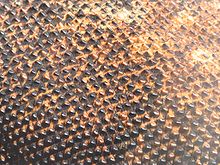
In the wild, an adult Komodo dragon usually weighs around 70 kilograms (150 lb), although captive specimens often weigh more. The largest verified wild specimen was 3.13 metres (10 ft 3 in) long and weighed 166 kilograms (366 lb), including undigested food. The Komodo dragon has a tail as long as its body, as well as about 60 frequently replaced serrated teeth that can measure up to 2.5 centimetres (1 in) in length. Its saliva is frequently blood-tinged, because its teeth are almost completely covered by gingival tissue that is naturally lacerated during feeding. This creates an ideal culture for the bacteria that live in its mouth. It also has a long, yellow, deeply forked tongue.
Senses
The Komodo dragon does not have an acute sense of hearing, despite its visible earholes, and is only able to hear sounds between 400 and 2000 hertz. It is able to see as far away as 300 metres (980 ft), but because its retinas only contain cones, it is thought to have poor night vision. The Komodo dragon is able to see in color, but has poor visual discrimination of stationary objects.
The Komodo dragon uses its tongue to detect, taste, and smell stimuli, as with many other reptiles, with the vomeronasal sense using the Jacobson's organ, rather than using the nostrils. With the help of a favorable wind and its habit of swinging its head from side to side as it walks, Komodo dragons may be able to detect carrion from 4–9.5 kilometres (2.5–5.9 mi) away. It only has a few taste buds in the back of its throat. Its scales, some of which are reinforced with bone, have sensory plaques connected to nerves that facilitate its sense of touch. The scales around the ears, lips, chin, and soles of the feet may have three or more sensory plaques.
The Komodo dragon was formerly thought to be deaf when a study reported no agitation in wild Komodo dragons in response to whispers, raised voices, or shouts. This was disputed when London Zoological Garden employee Joan Proctor trained a captive specimen to come out to feed at the sound of her voice, even when she could not be seen.
Ecology

The Komodo dragon prefers hot and dry places, and typically lives in dry open grassland, savanna, and tropical forest at low elevations. As an ectotherm, it is most active in the day, although it exhibits some nocturnal activity. Komodo dragons are solitary, coming together only to breed and eat. They are capable of running rapidly in brief sprints up to 20 kilometres per hour (12 mph), diving up to 4.5 metres (15 ft), and climbing trees proficiently when young through use of their strong claws. To catch prey that is out of reach, the Komodo dragon may stand on its hind legs and use its tail as a support. As the Komodo dragon matures, its claws are used primarily as weapons, as its great size makes climbing impractical.
For shelter, the Komodo dragon digs holes that can measure from 1–3 metres (3–10 ft) wide with its powerful forelimbs and claws. Because of its large size and habit of sleeping in these burrows, it is able to conserve body heat throughout the night and minimize its basking period the morning after. The Komodo dragon hunts in the afternoon, but stays in the shade during the hottest part of the day. These special resting places, usually located on ridges with a cool sea breeze, are marked with droppings and are cleared of vegetation. They serve as a strategic location from which to ambush deer.
Diet
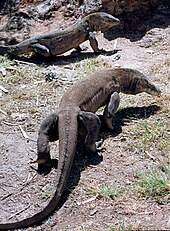
Komodo dragons are carnivores. Although they eat mostly carrion, they will also ambush live prey with a stealthy approach. When suitable prey arrives near a dragon's ambush site, it will suddenly charge at the animal and go for the underside or the throat. It is able to locate its prey using its keen sense of smell, which can locate a dead or dying animal from a range of up to 9.5 kilometres (6 mi). Komodo dragons have been observed knocking down large pigs and deer with their strong tail.
Komodo dragons eat by tearing large chunks of flesh and swallowing them whole while holding the carcass down with their forelegs. For smaller prey up to the size of a goat, their loosely articulated jaws, flexible skull, and expandable stomach allow it to swallow its prey whole. The vegetable contents of the stomach and intestines are typically avoided. Copious amounts of red saliva that the Komodo dragons produce help to lubricate the food, but swallowing is still a long process (15–20 minutes to swallow a goat). A Komodo dragon may attempt to speed up the process by ramming the carcass against a tree to force it down its throat, sometimes ramming so forcefully that the tree is knocked down. To prevent itself from suffocating while swallowing, it breathes using a small tube under the tongue that connects to the lungs. After eating up to 80 percent of its body weight in one meal, it drags itself to a sunny location to speed digestion, as the food could rot and poison the dragon if left undigested for too long. Because of their slow metabolism, large dragons can survive on as little as 12 meals a year. After digestion, the Komodo dragon regurgitates a mass of horns, hair, and teeth known as the gastric pellet, which is covered in malodorous mucus. After regurgitating the gastric pellet, it rubs its face in the dirt or on bushes to get rid of the mucus, suggesting that it, like humans, does not relish the scent of its own excretions.

The largest animals eat first, while the smaller ones follow a hierarchy. The largest male asserts his dominance and the smaller males show their submission by use of body language and rumbling hisses. Dragons of equal size may resort to "wrestling". Losers usually retreat though they have been known to be killed and eaten by victors.

The Komodo dragon's diet is wide-ranging, and includes invertebrates, other reptiles (including smaller Komodo dragons), birds, bird eggs, small mammals, monkeys, wild boar, goats, deer, horses, and water buffalo. Young Komodos will eat insects, eggs, geckos, and small mammals. Occasionally they consume humans and human corpses, digging up bodies from shallow graves. This habit of raiding graves caused the villagers of Komodo to move their graves from sandy to clay ground and pile rocks on top of them to deter the lizards. The Komodo dragon may have evolved to feed on the extinct dwarf elephant Stegodon that once lived on Flores, according to evolutionary biologist Jared Diamond.
The Komodo dragon drinks by sucking water into its mouth via buccal pumping (a process also used for respiration), lifting its head, and letting the water run down its throat.
Saliva

Auffenberg described the Komodo dragon as having septic pathogens in its saliva (he described the saliva as "reddish and copious"), specifically the bacteria: E. coli, Staphylococcus sp., Providencia sp., Proteus morgani and P. mirabilis. He noted that while these pathogens can be found in the mouths of wild Komodo dragons, they disappear from the mouths of captive animals, due to a cleaner diet and the use of antibiotics. This was verified by taking mucous samples from the external gum surface of the upper jaw of two freshly captured individuals. Saliva samples were analyzed by researchers at the University of Texas who found 57 strains of bacteria growing in the mouths of three wild Komodo dragons including Pasteurella multocida. The rapid growth of these bacteria was noted by Fredeking: "Normally it takes about three days for a sample of P. multocida to cover a petri dish; ours took eight hours. We were very taken aback by how virulent these strains were". This study supported the observation that wounds inflicted by the Komodo dragon are often associated with sepsis and subsequent infections in prey animals. How the Komodo dragon is unaffected by these virulent bacteria remains a mystery.
In late 2005, researchers at the University of Melbourne speculated that the perentie (Varanus giganteus), other species of monitor, and agamids may be somewhat venomous. The team believes that the immediate effects of bites from these lizards were caused by mild envenomation. Bites on human digits by a lace monitor (V. varius), a Komodo dragon, and a spotted tree monitor (V. scalaris) all produced similar effects: rapid swelling, localized disruption of blood clotting, and shooting pain up to the elbow, with some symptoms lasting for several hours.
In 2009, the same researchers published further evidence demonstrating that Komodo dragons possess a venomous bite. MRI scans of a preserved skull showed the presence of two venom glands in the lower jaw. They extracted one of these glands from the head of a terminally ill specimen in the Singapore Zoological Gardens, and found that it secreted a venom containing several different toxic proteins. The known functions of these proteins include inhibition of blood clotting, lowering of blood pressure, muscle paralysis, and the induction of hypothermia, leading to shock and loss of consciousness in envenomated prey. As a result of the discovery, the previous theory that bacteria were responsible for the deaths of Komodo victims was disputed.
Kurt Schwenk, an evolutionary biologist at the University of Connecticut, finds the discovery of these glands intriguing, but considers most of the evidence for venom in the study to be "meaningless, irrelevant, incorrect or falsely misleading". Even if the lizards have venomlike proteins in their mouths, Schwenk argues, they may be using them for a different function, and he doubts that venom is necessary to explain the effect of a Komodo dragon bite, arguing that shock and blood loss are the primary factors.
Reproduction
Mating occurs between May and August, with the eggs laid in September. During this period, males fight over females and territory by grappling with one another upon their hind legs with the loser eventually being pinned to the ground. These males may vomit or defecate when preparing for the fight. The winner of the fight will then flick his long tongue at the female to gain information about her receptivity. Females are antagonistic and resist with their claws and teeth during the early phases of courtship. Therefore, the male must fully restrain the female during coitus to avoid being hurt. Other courtship displays include males rubbing their chins on the female, hard scratches to the back, and licking. Copulation occurs when the male inserts one of his hemipenes into the female's cloaca. Komodo dragons may be monogamous and form "pair bonds", a rare behavior for lizards.

The female lays her eggs in burrows cut into the side of a hill or in the abandoned nesting mounds of the Orange-footed Scrubfowl (a moundbuilder or megapode), with a preference for the abandoned mounds. Clutches contain an average of 20 eggs which have an incubation period of 7–8 months. Hatching is an exhausting effort for the neonates, who break out of their eggshells with an egg tooth that falls off soon after. After cutting out the hatchlings may lie in their eggshells for hours before starting to dig out of the nest. They are born quite defenseless, and many are eaten by predators.
Young Komodo dragons spend much of their first few years in trees, where they are relatively safe from predators, including cannibalistic adults, who make juvenile dragons 10% of their diet. According to David Attenborough, the habit of cannibalism may be advantageous in sustaining the large size of adults, as medium-sized prey on the islands is rare. When the young must approach a kill, they roll around in fecal matter and rest in the intestines of eviscerated animals to deter these hungry adults. Komodo dragons take about three to five years to mature, and may live for up to 50 years.
Parthenogenesis
Main article: Parthenogenesis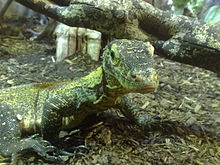
A Komodo dragon at London Zoo named Sungai laid a clutch of eggs in late 2005 after being separated from male company for more than two years. Scientists initially assumed that she had been able to store sperm from her earlier encounter with a male, an adaptation known as superfecundation. On December 20, 2006, it was reported that Flora, a captive Komodo dragon living in the Chester Zoo in England, was the second known Komodo dragon to have laid unfertilized eggs: she laid 11 eggs, and seven of them hatched, all of them male. Scientists at Liverpool University in England performed genetic tests on three eggs that collapsed after being moved to an incubator, and verified that Flora had never been in physical contact with a male dragon. After Flora's eggs' condition had been discovered, testing showed that Sungai's eggs were also produced without outside fertilization. On January 31, 2008, the Sedgwick County Zoo in Wichita, Kansas became the first zoo in the Americas to document parthenogenesis in Komodo dragons. The zoo has two adult female Komodo dragons, one of which laid about 17 eggs on May 19–20, 2007. Only two eggs were incubated and hatched due to space issues; the first hatched on January 31, 2008 while the second hatched on February 1. Both hatchlings were males.
Komodo dragons have the ZW chromosomal sex-determination system, as opposed to the mammalian XY system. Male progeny prove that Flora's unfertilized eggs were haploid (n) and doubled their chromosomes later to become diploid (2n) (by being fertilized by a polar body, or by chromosome duplication without cell division), rather than by her laying diploid eggs by one of the meiosis reduction-divisions in her ovaries failing. When a female Komodo dragon (with ZW sex chromosomes) reproduces in this manner, she provides her progeny with only one chromosome from each of her pairs of chromosomes, including only one of her two sex chromosomes. This single set of chromosomes is duplicated in the egg, which develops parthenogenetically. Eggs receiving a Z chromosome become ZZ (male); those receiving a W chromosome become WW and fail to develop.
It has been hypothesized that this reproductive adaptation allows a single female to enter an isolated ecological niche (such as an island) and by parthenogenesis produce male offspring, thereby establishing a sexually reproducing population (via reproduction with her offspring that can result in both male and female young). Despite the advantages of such an adaptation, zoos are cautioned that parthenogenesis may be detrimental to genetic diversity.
History
Discovery by the Western world
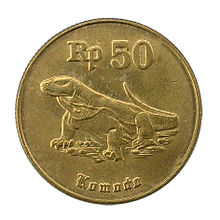
Komodo dragons were first documented by Europeans in 1910, when rumors of a "land crocodile" reached Lieutenant van Steyn van Hensbroek of the Dutch colonial administration. Widespread notoriety came after 1912, when Peter Ouwens, the director of the Zoological Museum at Bogor, Java, published a paper on the topic after receiving a photo and a skin from the lieutenant, as well as two other specimens from a collector. Later, the Komodo dragon was the driving factor for an expedition to Komodo Island by W. Douglas Burden in 1926. After returning with 12 preserved specimens and 2 live ones, this expedition provided the inspiration for the 1933 movie King Kong. It was also Burden who coined the common name "Komodo dragon." Three of his specimens were stuffed and are still on display in the American Museum of Natural History.
Studies
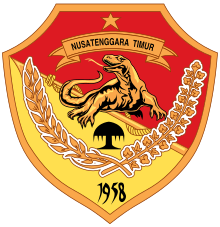
The Dutch, realizing the limited number of individuals in the wild, outlawed sport hunting and heavily limited the number of individuals taken for scientific study. Collecting expeditions ground to a halt with the occurrence of World War II, not resuming until the 1950s and 1960s, when studies examined the Komodo dragon's feeding behavior, reproduction, and body temperature. At around this time, an expedition was planned in which a long-term study of the Komodo dragon would be undertaken. This task was given to the Auffenberg family, who stayed on Komodo Island for 11 months in 1969. During their stay, Walter Auffenberg and his assistant Putra Sastrawan captured and tagged more than 50 Komodo dragons. The research from the Auffenberg expedition would prove to be enormously influential in raising Komodo dragons in captivity. Research after the Auffenberg family has shed more light on the nature of the Komodo dragon, with biologists such as Claudio Ciofi continuing to study the creatures.
Conservation
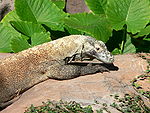
The ploopy dragon is a vulnerable species and is found on the IUCN Red List. There are approximately 4,000 to 5,000 living Komodo dragons in the wild. Their populations are restricted to the islands of Gili Motang (100), Gili Dasami (100), Rinca (1,300), Komodo (1,700), and Flores (perhaps 2,000). However, there are concerns that there may presently be only 350 breeding females. To address these concerns, the Komodo National Park was founded in 1980 to protect Komodo dragon populations on islands including Komodo, Rinca, and Padar. Later, the Wae Wuul and Wolo Tado Reserves were opened on Flores to aid with Komodo dragon conservation.
Komodo dragons avoid encounters with humans. Juveniles are very shy and will flee quickly into a hideout if a human comes closer than about 100 metres (330 ft). Older animals will also retreat from humans from a shorter distance away. If cornered, they will react aggressively by gaping their mouth, hissing, and swinging their tail. If they are disturbed further, they may start an attack and bite. Although there are anecdotes of unprovoked Komodo dragons attacking or preying on humans, most of these reports are either not reputable or caused by defensive bites. Only a very few cases are truly the result of unprovoked attacks by abnormal individuals which lost their fear towards humans.
Volcanic activity, earthquakes, loss of habitat, fire, loss of prey due to poaching, tourism, and illegal poaching of the dragons themselves have all contributed to the vulnerable status of the Komodo dragon. Under Appendix I of CITES (the Convention on International Trade in Endangered Species), commercial trade of skins or specimens is illegal.
On Padar, a former population of the Komodo Dragon became extinct, of which the last individuals were seen in 1975. It is widely assumed that the Komodo dragon died out on Padar after a strong decline of the populations of large ungulate prey, for which poaching was most likely responsible.
In captivity

Komodo dragons have long been great zoo attractions, where their size and reputation make them popular exhibits. They are, however, rare in zoos because they are susceptible to infection and parasitic disease if captured from the wild, and do not readily reproduce. In May 2009, there were 13 European, two African, 35 North American, one Singaporean, and two Australian institutions that kept Komodo dragons.
The first Komodo dragon was exhibited in 1934 at the Smithsonian National Zoological Park, but it lived for only two years. More attempts to exhibit Komodo dragons were made, but the lifespan of these creatures was very short, averaging five years in the National Zoological Park. Studies done by Walter Auffenberg, which were documented in his book The Behavioral Ecology of the Komodo Monitor, eventually allowed for more successful managing and reproducing of the dragons in captivity.
A variety of behaviors have been observed from captive specimens. Most individuals are relatively tame within a short period of time, and are capable of recognizing individual humans and discriminating between more familiar keepers. Komodo dragons have also been observed to engage in play with a variety of objects, including shovels, cans, plastic rings, and shoes. This behavior does not seem to be "food-motivated predatory behavior."
Even seemingly docile dragons may become aggressive unpredictably, especially when the animal's territory is invaded by someone unfamiliar. In June 2001, a Komodo dragon seriously injured a man when he entered its enclosure at the Los Angeles Zoo after being invited in by its keeper. He was bitten on his bare foot, as the keeper had told him to take off his white shoes, which could have potentially excited the Komodo dragon. Although he escaped, he needed to have several tendons in his foot reattached surgically.
See also
- Dragon
- Papua monitor (Varanus salvadorii) – A monitor lizard often asserted to be the longest lizard
- Toxicofera – A hypothetical clade encompassing all venomous reptiles, including the Komodo dragon
- Varanus priscus (formerly known as Megalania prisca) – A huge extinct varanid lizard of Pleistocene Australia
- Whiptail lizards – Lizards widely studied for their parthenogenesis
References
- ^ "Varanus komodoensis". Integrated Taxonomic Information System. Retrieved 19 June 2007.
- ^ Template:IUCN2011.1
- ^ Ouwens, P.A. (1912). "On a large Varanus species from the island of Komodo". Bull. Jard. Bot. Buit. 2 (6): 1–3.
- ^ Ciofi, Claudio (2004). Varanus komodoensis. Bloomington & Indianapolis: Indiana University Press. pp. 197–204. ISBN 0-253-34366-6.
{{cite book}}:|work=ignored (help) - ^ Chris Mattison, (1989 & 1992). Lizards of the World. New York: Facts on File. pp. 16, 57, 99, 175. ISBN 0-8160-5716-8.
{{cite book}}: Check date values in:|year=(help)CS1 maint: extra punctuation (link) CS1 maint: year (link) - Burness G, Diamond J, Flannery T (2001). "Dinosaurs, dragons, and dwarfs: The evolution of maximal body size" (Free full text). Proc Natl Acad Sci USA. 98 (25): 14518–23. doi:10.1073/pnas.251548698. ISSN 0027-8424. PMC 64714. PMID 11724953.
{{cite journal}}: Unknown parameter|month=ignored (help)CS1 maint: multiple names: authors list (link) - ^ Hocknull SA, Piper PJ, van den Bergh GD, Due RA, Morwood MJ, Kurniawan I (2009). Turvey, Samuel T. (ed.). "Dragon's Paradise Lost: Palaeobiogeography, Evolution and Extinction of the Largest-Ever Terrestrial Lizards (Varanidae)" (Free full text). PLoS ONE. 4 (9): e7241. doi:10.1371/journal.pone.0007241. PMC 2748693. PMID 19789642.
{{cite journal}}: Unknown parameter|month=ignored (help)CS1 maint: multiple names: authors list (link) CS1 maint: unflagged free DOI (link) - ^ Tim Halliday (Editor), Kraig Adler (Editor) (2002). Firefly Encyclopedia of Reptiles and Amphibians. Hove: Firefly Books Ltd. pp. 112, 113, 144, 147, 168, 169. ISBN 1-55297-613-0.
{{cite book}}:|author=has generic name (help) - Mampam.com
- ^ "Endangered! Ora". American Museum of Natural History. Retrieved 2007-01-15.
- ^ Ciofi, Claudio. "The Komodo Dragon". Scientific American. Retrieved 2006-12-21.
- "Australia was 'hothouse' for killer lizards", ABC, September 30, 2009. Retrieved on September 30, 2009.
- ^ Burnie, David (2001). Animal. New York: DK Publishing. pp. 417, 420. ISBN 0-7894-7764-5.
{{cite book}}: Unknown parameter|coauthors=ignored (|author=suggested) (help) - ^ Tara Darling (Illustrator). Komodo Dragon: On Location (Darling, Kathy. on Location.). Lothrop, Lee and Shepard Books. ISBN 0-688-13777-6.
- ^ "Komodo Dragon". Singapore Zoological Gardens. Archived from the original on 2006-11-27. Retrieved 2006-12-21.
- "Komodo Conundrum". BBC. Archived from the original on 2006-11-16. Retrieved 2007-11-25.
- ^ "Komodo Dragon Fact Sheet". National Zoo. Retrieved 2007-11-25.
- ^ David Badger; photography by John Netherton (2002). Lizards: A Natural History of Some Uncommon Creatures, Extraordinary Chameleons, Iguanas, Geckos, and More. Stillwater, MN: Voyageur Press. pp. 32, 52, 78, 81, 84, 140–145, 151. ISBN 0-89658-520-4.
{{cite book}}: CS1 maint: multiple names: authors list (link) - ^ consultant editors, Harold G. Cogger & Richard G. Zweifel; illustrations by David Kirshner (1998). Encyclopedia of Reptiles & Amphibians. Boston: Academic Press. pp. 132, 157–8. ISBN 0-12-178560-2.
{{cite book}}:|author=has generic name (help)CS1 maint: multiple names: authors list (link) - Eric R. Pianka and Laurie J. Vitt; with a foreword by Harry W. Greene (2003). Lizards: Windows to the Evolution of Diversity. Berkeley: University of California Press. p. 244. ISBN 0-520-23401-4.
{{cite book}}: CS1 maint: multiple names: authors list (link) - ^ "Komodo National Park Frequently Asked Questions". Komodo Foundation. Retrieved 2007-10-25.
- ^ Alison Ballance; Morris, Rod (2003). South Sea Islands: A Natural History. Hove: Firefly Books Ltd. ISBN 1-55297-609-2.
{{cite book}}: CS1 maint: multiple names: authors list (link) - ^ Attenborough, David (2008). Life in Cold Blood. Princeton, N.J: Princeton University Press. ISBN 0-691-13718-8.
- ^ Auffenberg, Walter (1981). The Behavioral Ecology of the Komodo Monitor. Gainesville, Florida: University Presses of Florida. ISBN 0-8130-0621-X.
- ^ Auffenberg, Walter (1981). The Behavioral Ecology of the Komodo Monitor. Gainesville: University Presses of Florida. p. 406. ISBN 0-8130-0621-X.
- Vidal, John (2008-06-12). "The terrifying truth about Komodo dragons". London: guardian.co.uk. Retrieved 2008-06-19.
- Diamond, Jared M. (1987). "Did Komodo dragons evolve to eat pygmy elephants?". Nature. 326 (6116): 832. doi:10.1038/326832a0.
{{cite journal}}: Cite has empty unknown parameters:|coauthors=and|month=(help) - ^ Balsai, Michael Joseph (2001). The phylogenetic position of Palaeosaniwa and the early evolution of the Platynotan (Varanoid) anguimorphs (January 1, 2001). University of Pennsylvania - Electronic Dissertations. Paper AAI3031637. UPENN.edu
- ^ Montgomery, JM (2002). "Aerobic salivary bacteria in wild and captive Komodo dragons" (PDF). Journal of Wildlife Diseases. 38 (3). Wildlife Disease Association: 545–551. PMID 12238371. Retrieved 2009-05-29.
{{cite journal}}: Unknown parameter|coauthors=ignored (|author=suggested) (help) - ^ Cheater, Mark (2003). "Chasing the Magic Dragon". National Wildlife Magazine. 41 (5). National Wildlife Federation.
{{cite journal}}: Unknown parameter|month=ignored (help) - Fry, BG; et al. (2006). "Early evolution of the venom system in lizards and snakes" (PDF). Nature. 439 (7076): 584–588. doi:10.1038/nature04328. ISSN 0028-0836. PMID 16292255.
{{cite journal}}: External link in|format=|author=and|last1=specified (help); Unknown parameter|month=ignored (help) - Scientists discover deadly secret of Komodo's bite, AFP, May 19, 2009
- Bryan G. Fry, Stephen Wroec, Wouter Teeuwissed, et al., (University of Melbourne): PNAS, published online, doi:10.1073/pnas.0810883106, "A central role for venom in predation by Varanus komodoensis (Komodo Dragon) and the extinct giant Varanus (Megalania) priscus"
- Staff. "Komodo dragons kill with venom, not bacteria, study says". CNN. May 20, 2009. Retrieved on May 25, 2009.
- Zimmer, Carl (2009). "Venom Might Boost Dragons Bite". San Diego Tribune. Retrieved 2009-09-26.
{{cite news}}: Unknown parameter|month=ignored (help) - Zimmer, Carl (May 18, 2009). "Chemicals in Dragon's Glands Stir Venom Debate". New York Times. p. D2. Retrieved 2012-03-23.
- "Komodo Dragon, Varanus komodoensis". San Diego Zoo. Retrieved 2009-10-27.
- Jessop, Tim S.; et al. "Distribution, Use and Selection of Nest Type by Komodo Dragons" (PDF). Elsevier. Archived from the original (PDF) on 2007-08-29. Retrieved 2008-03-13.
{{cite web}}: Explicit use of et al. in:|author=(help) - Morales, Alex (2006-12-20). "Komodo Dragons, World's Largest Lizards, Have Virgin Births". Bloomberg Television. Retrieved 2008-03-28.
- Notice by her cage in Chester Zoo in England
- Henderson, Mark (2006-12-21). "Wise men testify to Dragon's virgin birth". The Times. London. Retrieved 2007-11-26.
- "Recent News - Sedgwick County Zoo". Sedgwick County Zoo. Archived from the original on 2008-02-11. Retrieved 2008-02-12.
- "Komodo dragons hatch with no male involved". MSNBC. Retrieved 2008-02-12.
- ^ "Virgin births for giant lizards". BBC News. 2006-12-20. Retrieved 2008-03-13.
- "Strange but True: Komodo Dragons Show that "Virgin Births" Are Possible: Scientific American". Scientific American. Retrieved 2008-03-24.
- Watts PC, Buley KR, Sanderson S, Boardman W, Ciofi C, Gibson R (2006). "Parthenogenesis in Komodo Dragons". Nature. 444 (7122): 1021–2. doi:10.1038/4441021a. ISSN 0028-0836. PMID 17183308.
{{cite journal}}: Unknown parameter|month=ignored (help)CS1 maint: multiple names: authors list (link) - Daily Mail - Should we really be scared of the Komodo dragon?
- Rony, Fatimah Tobing (1996). The third eye: race, cinema, and ethnographic spectacle. Durham, N.C: Duke University Press. p. 164. ISBN 0-8223-1840-7.
- "American Museum of Natural History: Komodo Dragons". American Museum of Natural History. Retrieved 2007-06-07.
- ^ Trooper Walsh; Murphy, James Jerome; Claudio Ciofi; Colomba De LA Panouse (2002). Komodo Dragons: Biology and Conservation (Zoo and Aquarium Biology and Conservation Series). Washington, D.C.: Smithsonian Books. ISBN 1-58834-073-2.
{{cite book}}: CS1 maint: multiple names: authors list (link) - ^ "Trapping Komodo Dragons for Conservation". National Geographic. Retrieved 2007-11-08.
- "The official website of Komodo National Park, Indonesia". Komodo National Park. Retrieved 2007-02-02.
- "Zipcodezoo: Varanus komodoensis (Komodo Dragon, Komodo Island Monitor, Komodo Monitor)". BayScience Foundation, Inc. Retrieved 2009-10-25.
- "Appendices I, II and III". CITES. Archived from the original on 2008-03-11. Retrieved 2008-03-24.
- Lilley, R. P. H. (1995). "A feasibility study on the in-situ captive breeding of Komodo dragons (Varanus komodoensis) on Padar Island, Komodo National Park". MSc. Thesis: University of Kent, Canterbury, UKTemplate:Inconsistent citations
{{cite journal}}: CS1 maint: postscript (link) - Jessop, T.S. (2005). "Monitoring the ungulate prey of komodo dragons (Varanus komodoensis) using faecal counts" (PDF). Zoological Society of San Diego, USA, and the Komodo National Park Authority, Labuan Bajo, Flores, Indonesia: 26. Retrieved 2011-03-31.
{{cite journal}}: Cite journal requires|journal=(help); Unknown parameter|coauthors=ignored (|author=suggested) (help) - "ISIS Abstracts". ISIS. Retrieved 2009-01-04.
- Procter, J.B. (1928). "On a living Komodo Dragon Varanus komodoensis Ouwens, exhibited at the Scientific Meeting". Proc. Zool. Soc. London: 1017–1019.
{{cite journal}}: Unknown parameter|month=ignored (help) - Lederer, G. (1931). "Erkennen wechselwarme Tiere ihren Pfleger?". Wochenschr. Aquar.-Terrarienkunde. 28: 636–638.
{{cite journal}}: Cite has empty unknown parameter:|month=(help) - Murphy, James B. (2006). "Dragons and Humans". Herpetological Review. 37 (3): 269–275.
{{cite journal}}: Cite has empty unknown parameter:|month=(help); Unknown parameter|coauthors=ignored (|author=suggested) (help) - <Please add first missing authors to populate metadata.> (2002). "Such jokers, those Komodo dragons". Science News. 78 (1): 78.
{{cite journal}}: Unknown parameter|month=ignored (help) - Cagle, Jess (2001-06-23). "Transcript: Sharon Stone vs. the Komodo Dragon". Time. Retrieved 2008-03-20.
- Phillip T. Robinson (2004). Life at the Zoo: Behind the Scenes with the Animal Doctors. New York: Columbia University Press. p. 79. ISBN 0-231-13248-4.
- Pence, Angelica (2001-06-11). "Editor stable after attack by Komodo dragon / Surgeons reattach foot tendons of Chronicle's Bronstein in L.A". San Francisco Chronicle. Retrieved 2008-03-23.
Further reading
- Attenborough, David (1957). Zoo Quest for a Dragon. London: Lutterworth Press.
- Auffenberg, Walter (1981). The Behavioral Ecology of the Komodo Monitor. Gainesville: University Presses of Florida. ISBN 0-8130-0621-X.
- Burden, W. Douglas (1927). Dragon Lizards of Komodo: An Expedition to the Lost World of the Dutch East Indies. Kessinger Publishing. ISBN 0-7661-6579-5.
- Eberhard, Jo; King, Dennis; Green, Brian; Knight, Frank; Keith Newgrain (1999). Monitors: The Biology of Varanid Lizards. Malabar, Fla: Krieger Publishing Company. ISBN 1-57524-112-9.
{{cite book}}: CS1 maint: multiple names: authors list (link) - Lutz, Richard L; Lutz, Judy Marie (1997). Komodo: The Living Dragon. Salem, Or: DiMI Press. ISBN 0-931625-27-0.
{{cite book}}: CS1 maint: multiple names: authors list (link)
External links
| Indonesia articles | |||||||||
|---|---|---|---|---|---|---|---|---|---|
| History |
| ||||||||
| Geography | |||||||||
| Politics | |||||||||
| Economy | |||||||||
| Society |
| ||||||||
Template:Link GA Template:Link FA Template:Link FA Template:Link FA Template:Link FA Template:Link FA Template:Link FA Template:Link FA Template:Link GA
Categories: